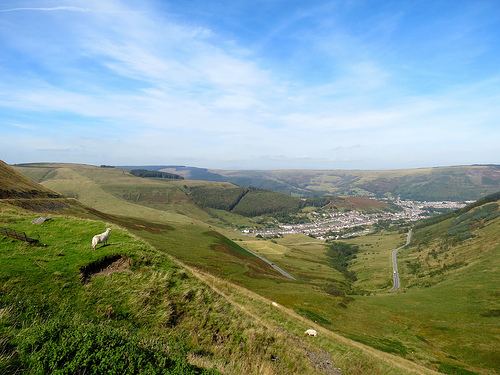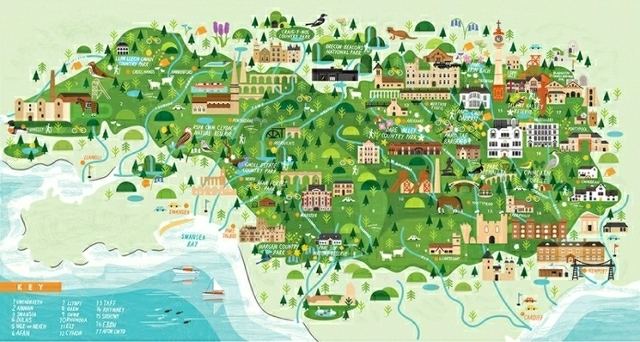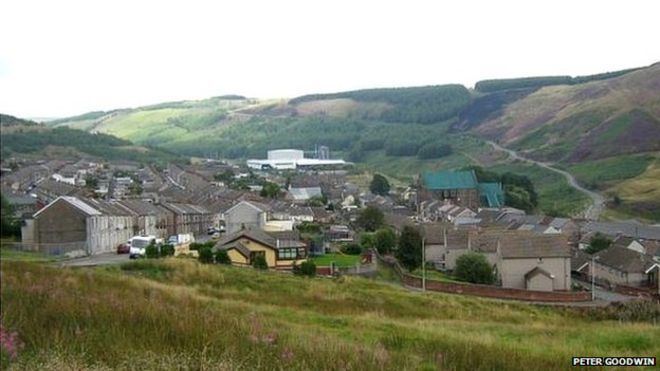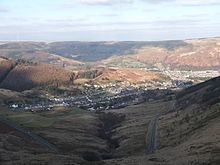 | ||
The South Wales Valleys (Welsh: Cymoedd De Cymru) are a number of industrialised valleys in South Wales. Commonly referred to locally as The Valleys (Welsh: Y Cymoedd), they stretch from eastern Carmarthenshire in the west to western Monmouthshire in the east and from the Heads of the Valleys in the north to the edge of the lower-lying, pastoral country of the Vale of Glamorgan and the coastal plain around Swansea Bay, Bridgend, the capital Cardiff, and Newport. Many of the valleys run roughly parallel to each other. The Rhondda Valleys and the Cynon Valley are located roughly in the centre.
Contents

History

Until the mid-nineteenth century, the South Wales valleys were lightly inhabited. The industrialisation of the Valleys occurred in two phases. First, in the second half of the 18th century, the iron industry was established on the northern edge of the Valleys, mainly by English entrepreneurs. This made South Wales the most important part of British ironmaking until the middle of the 19th century. Second, from 1850 to the outbreak of the First World War, the South Wales Coalfield was developed to supply steam coal and anthracite.

The South Wales Valleys were Britain's only mountainous coalfield. Topography defined the shape of the mining communities, with a 'hand and fingers' pattern of urban development. There were fewer than 1,000 people in the Rhondda in 1851, 17,000 by 1870, 114,000 by 1901 and 153,000 by 1911; but the wider impact of urbanisation was constrained by geography - the Rhondda remained a collection of villages rather than a town in its own right. The population of the Valleys in the late 19th and early 20th centuries was disproportionately young and male, often migrants drawn from other parts of Wales or further afield. The new communities had extremely high birth rates - in 1840, more than 20% of Tredegar's population was aged under 7, and Rhondda's birth rate in 1911 was 36 per thousand, levels usually associated with mid-19th century Britain.

Merthyr Tydfil, at the northern end of the Taff valley became Wales's largest town thanks to its growing ironworks at Dowlais and Cyfarthfa Ironworks. The neighbouring Taff Bargoed Valley situated to the east became the centre of serious industrial and political strife during the 1930s, especially in and around the villages of Trelewis and Bedlinog which served the local collieries of Deep Navigation and Taff Merthyr. The South Wales coalfield attracted huge numbers of people from rural areas to the valleys. This meant that many rows of terraced housing were built along the valley sides to accommodate the influx. The coal mined in the valleys was transported south along railways and canals to ports on the Bristol Channel, notably Cardiff, Newport and Swansea. Cardiff was soon among the most important coal ports in the world and Swansea among the most important steel ports.
Decline

The coal mining industry of the South Wales Valleys was artificially buoyed throughout the war years, though there were expectations of a return to the pre-1939 industrial collapse after the end of the Second World War. There was a sense of salvation when the government announced the nationalisation of British coalmines in 1947; but the following decades saw a continual reduction in the output from the Welsh mines. The decline in the mining of coal after World War II was a country wide issue, but South Wales and Rhondda were affected to a higher degree than other areas of Britain. Oil had superseded coal as the fuel of choice in many industries and there was political pressure influencing the supply of oil. Of the few industries that were still reliant on coal, the demand was for quality coals, especially coking coal which was required by the steel industry. Fifty percent of Glamorgan coal was now supplied to steelworks, with the second biggest market being domestic heating, which the "smokeless" coal of the South Wales coalfield became once again fashionable after the publication of the Clean Air Act. These two markets now controlled the fate of the mines in South Wales, and as demand fell from both sectors the knock-on effect on the mining industry was further contraction. In addition exports to other areas of Europe, traditionally France, Italy and the Low Countries, experienced a massive decline; from 33 per cent at the turn of the century to roughly 5 per cent by 1980.

The other major factors in the decline of coal were related to the massive under-investment in South Wales mines over the past decades. Most of the mines in the valleys were sunk between the 1850s and 1880s, which, as a consequence, meant they were far smaller than most modern mines. The Welsh mines were in comparison antiquated, with methods of ventilation, coal-preparation and power supply all of a poor standard. In 1945 the British coal industry cut 72 per cent of their output mechanically, whereas in South Wales the figure was just 22 per cent. The only way to ensure the financial survival of the mines in the valleys was massive investment from the NCB, but the 'Plan for Coal' paper drawn up in 1950 was overly optimistic in the future demand for coal, which was drastically reduced following an industrial recession in 1956 and an increased availability of oil. From 15,000 miners in 1947, Rhondda had just a single pit within the valleys producing coal in 1984, located at Maerdy.
In 1966, the village of Aberfan in the Taff valley suffered one of the worst disasters in Welsh history. A mine waste tip on the top of the mountain, which had been developed over a spring, slid down the valley side and destroyed the village primary school, killing 144 people, 116 of them children.
In 1979, Margaret Thatcher became Prime Minister of the United Kingdom. Her policies of free market economics soon clashed with the loss-making, government-owned National Coal Board. In 1984 and 1985, after the government announced plans to close many mines across the UK, mineworkers went on strike. The ultimate failure of this strike led to the virtual destruction of the UK's coal industry over the next decade, although arguably costs of extraction and geological difficulties would have had the same result, perhaps a little later. No deep coal mines are left in the valleys since the closure in 2008 of Tower Colliery in the Cynon Valley. Tower had been bought by the workers in 1994, despite government attempts to close it.
Since the mid-1980s, unemployment rates in the valleys have been among the highest in the whole United Kingdom, and have been seen as a major factor in the rise in drug abuse in the local area, which was highlighted in the national media during the autumn of 2002 and largely linked to drug dealing gangs from Birmingham and Bristol.
In the new millennium, the last of the steel works closed, as Corus Group (formerly British Steel plc) closed its plant in Ebbw Vale.
Demographics and employment
The Valleys are home to around 30% of the Welsh population, although this is declining slowly because of emigration, especially from the Upper Valleys. The area is less diverse than the rest of the country, with a relatively high proportion of residents (over 90% in Blaenau Gwent and Merthyr Tydfil) born in Wales. High rates of teenage pregnancy give the area a slightly younger age profile than Wales as a whole.
The Valleys suffer from a number of socio-economic problems. Educational attainment in the Valleys is low, with a large proportion of people possessing few or no qualifications. A high proportion of people report a limiting long-term health problem, especially in the Upper Valleys. In 2006, only 64% of the working age population in the Heads of the Valleys was in employment compared with 69% in the Lower Valleys and 71% across Wales as a whole.
A relatively large number of local people are employed in manufacturing, health and social services. Fewer work in managerial or professional occupations, and more in elementary occupations, compared to the rest of the country. A large number of people commute to Cardiff, particularly in Caerphilly, Torfaen and Rhondda Cynon Taf. Though the rail network into Cardiff is extensive, train times and frequencies beyond Caerphilly and Pontypridd impede the development of a significant commuter market to city centre jobs.
Although the housing stock is not of significantly worse quality than elsewhere in Wales, there is a lack of variety in terms of private dwellings. Many homes are low-priced, older and terraced, concentrated in the lowest Council Tax bands; few are higher-priced detached homes. A report for the Welsh Assembly Government concluded that the Valleys is "a distressed area unique in Great Britain for the depth and concentration of its problems". However, the area does benefit from a local landscape described as "stunning", improving road links such as the upgraded A465, and public investment in regeneration initiatives.
Culture
The South Wales Valleys became a symbol of the whole of Wales for many foreign people and people in the rest of the United Kingdom. The valleys do, however, contain a large proportion of the Welsh population and remain an important centre of Welsh culture, despite the growing dominance of Cardiff. The UK parliament's first Labour Party MP, Keir Hardie was elected from the area and the Valleys remain a stronghold of Labour Party power. Rugby union is very popular and pitches can be seen along the valley floors. Football is also popular in the valleys, as in the rest of the UK. The area was overwhelmingly Welsh-speaking at the end of the nineteenth century, but today, English is most commonly the everyday language.
The geographical shape of the valleys have their effect on culture. Many roads stretch along valleys connecting the different settlements in the valley. Consequently, the different towns in a valley are more closely associated with each other than they are with towns in the neighbouring valley, even when the towns in the neighbouring valley are closer on the map.
Transport
The A470 from Cardiff to Llandudno is, until its junction with the A465 Heads of the Valleys road, a dual carriageway providing direct access to Taff's Well, Pontypridd, Abercynon and Merthyr Tydfil. It links with the A4059 from Abercynon, Aberdare and Hirwaun; the A472 from Ystrad Mynach and Pontypool, and the A4054 from Quakers Yard. The A465 provides a strategic link for the northern Valleys, and an alternative route between South West Wales and the Midlands. The dualling of this road will be completed by 2020. Stagecoach in South Wales provides bus services linking many towns and villages directly to Cardiff city centre.
Many settlements in the Valleys are served by the Valley Lines network, an urban rail network radiating from Cardiff which links them to the city's stations, principally Cardiff Queen Street and Cardiff Central, with connections onto the South Wales Main Line. There are six main lines from Central Cardiff to the Valleys:
List of valleys in South Wales
From west to east:
Two further valleys to the east and north are not considered to be a part of the "South Wales Valleys" region:
